Cobia
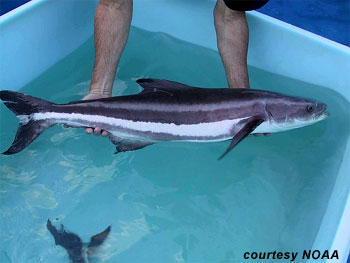
Rachycentron canadum
This torpedo-shaped fish has a long, pointed face and slightly depressed head that swoops back to a row of spines spaced out in front of its dorsal fin. With triangular, curved fins and crescent tail, as well as dark olive-brown on top and silver grey below coloring, it resembles a small shark in profile. These pelagic fish prefer the open sea but tend to reside near pilings buoys, boats, and flotsam where they gather in groups to scavenge crustaceans, cephalopods, and small fishes. Because they are fast growing and considered a good food fish, they are both commercially harvested, and recreationally fished, although care should be taken handling them because of the row of dorsal spines.
Order: Perciformes
Family: Rachycentridae
Genus: Rachycentron
Species: canadum
Common Names
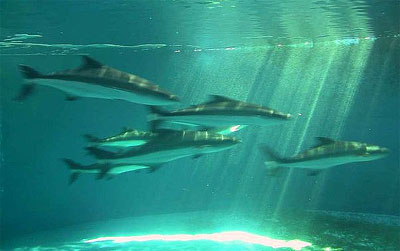
English language common names are cobia, black kingfish, black salmon, cabio, crabeater, cubby yew, kingfish, lemonfish, ling, prodigal son, runner, sergeant fish, and sergeantfish. Other names include aruan tasek (Malay), bacalao (Spanish), bacalhau (Portuguese), balisukan (Bikol), bonita (Susu), bonito (Spanish), cobie (Spanish), cuddul-verari (Sinhalese), dalag-dagat (Tagalog), foguesteiro-galego (Portuguese), gabus laut (Malay), gile (Tagalog), goada (Arabic), itang (Bikol), jaman (Malay), kadal-viral (Tamil), kobia (Afrikaans), kume (Visayan), kumi nu’aakhr (Arabic), langlanga (Maranao), mafou (French), mondoh (Javanese), mudhila (Sinhalese), ndjika (Portuguese), offiziersfisch (German), okakala (Finnish), pandauan (Bikol), pandawan (Cebuano), peixe-sargento (Portuguese), peje palo (Spanish), pejepalo (Spanish), rachica (Polish), sakalan itang (Bikol), seekel (Arabic), segel (Arabic), seheeha (Arabic), sikel (Arabic), sikin (Arabic), sungoro (Swahili), sugi (Japanese), takho (Somali), and tayad (Visayan).
Importance to Humans
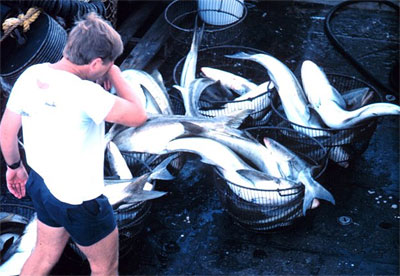
Cobia is considered an excellent game fish and are highly prized by recreational fishers. It is a powerful fish and exciting to catch on hook and line. In the US, cobia are caught commercially in pound nets, gill nets, and seines. They are also taken incidentally by shrimp trawlers and longliners in the Gulf of Mexico. Cobia are usually caught in small quantities due to their solitary existence. It is a good food fish for human consumption and is typically marketed fresh, frozen, or smoked.
Danger to Humans
There are 7-9 dorsal spines, each depressible into a groove, that are very sharp and stout. Care must be taken when handling these strong fish to avoid injury.
Conservation
The cobia is not listed as endangered or vulnerable with the World Conservation Union (IUCN). The IUCN is a global union of states, governmental agencies, and non-governmental organizations in a partnership that assesses the conservation status of species.
> Check the status of the cobia at the IUCN website.
Geographical Distribution
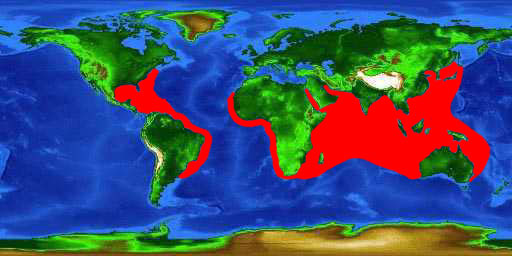
The cobia is distributed worldwide in tropical, subtropical and warm-temperate waters. In the western Atlantic Ocean this pelagic fish occurs from Nova Scotia (Canada), south to Argentina, including the Caribbean Sea. It is abundant in warm waters off the coast of the US from the Chesapeake Bay south and through out the Gulf of Mexico. During autumn and winter months, cobia migrate south and offshore to warmer waters. Cobia prefer water temperatures between 68°-86°F. Seeking shelter in harbors and around wrecks and reefs, the cobia is often found off south Florida and the Florida Keys. In early spring, migration occurs northward along the Atlantic coast. In the eastern Atlantic Ocean, cobia range from Morocco to South Africa and in the Indo-West Pacific from East Africa and Japan toAustralia. Cobia do not occur in the eastern Pacific Ocean.
Habitat
As a pelagic fish, cobia are found over the continental shelf as well as around offshore reefs. It prefers to reside near any structure that interrupts the open water such as pilings, buoys, platforms, anchored boats, and flotsam. The cobia is also found inshore inhabiting bays, inlets, and mangroves. Remoras are often seen swimming with cobia.
Biology
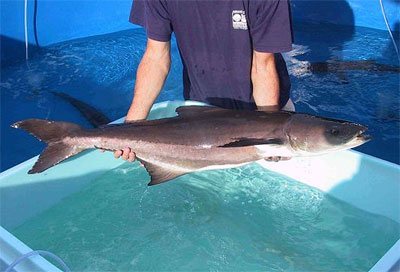
Distinctive Features
The body is elongate and torpedo-shaped with a long, depressed head. The eyes are small and the snout is broad. The lower jaw projects past the upper jaw. The skin looks smooth with very small embedded scales. Easily distinguished by the first dorsal fin which is composed of 7-9 short, strong isolated spines, not connected by a membrane. Second dorsal fin is long with the anterior portion elevated. The caudal fin is round to truncated in young fishes, and lunate in adults with the upper lobe extending past the lower. The origin of the anal fin is beneath the second dorsal apex and the pectoral fin is pointed. Cobia lack an air bladder.
Coloration
The body is dark brown to silver, paler on the sides and grayish white to silvery below, with two narrow dark bands extending from the snout to base of caudal fin. These dark bands are bordered above and below by paler bands. Young cobia have pronounced dark lateral bands, which tend to become obscured in the adult fish. Most fins are deep brown, with gray markings on the anal and pelvic fins.
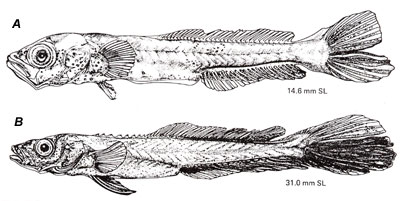
Dentition
Cobia have bands of villiform teeth on jaws, and on roof of mouth and tongue.
Size, Age, and Growth
Weighing up to a record 135 pounds (61 kg), cobia are more common at weights of up to 50 pounds (23 kg). They reach lengths of 20-47 inches (50-120 cm), with a maximum of 79 inches (200 cm). Cobia grow quickly and have a moderately long life span. Maximum ages observed for cobia in the Gulf of Mexico were 9 and 11 years for males and females respectively while off the North Carolina coast maximum ages were 14 and 13 years. Females reach sexual maturity at 3 years of age and males at 2 years in the Chesapeake Bay region. Cobia in other parts of the world may mature earlier.
Food Habits
As voracious eaters, cobia often engulf their prey whole. They are carnivores, feeding on crustaceans, cephalopods, and small fishes such as mullet, eels, jacks, snappers, pinfish, croakers, grunts, and herring. A favorite food is crabs, hence the common name of “crabeater”. Cobia often cruise in packs of 3-100 fish, hunting for food during migrations in shallow water along the shoreline. They are also known to feed in a manner similar to remoras. Cobia will follow rays, turtles, and sharks, sneaking in to scavenge whatever is left behind. Little is known about the feeding habits of larvae and juvenile cobia.
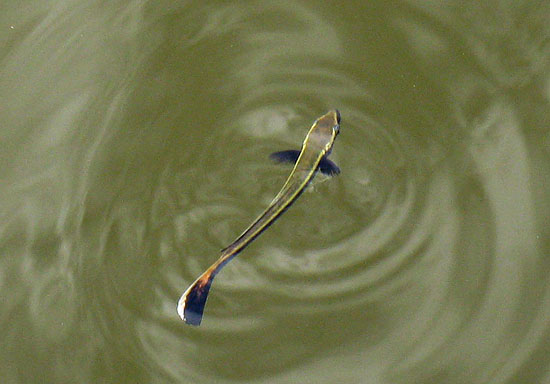
Reproduction
Cobia form large aggregations, spawning during daylight hours between June and August in the Atlantic Ocean near the Chesapeake Bay, off North Carolina in May and June, and in the Gulf of Mexico during April through September. Spawning frequency is once every 9-12 days, spawning 15-20 times during the season. During spawning, cobia undergo changes in body coloration from brown to a light horizontal-striped pattern, releasing eggs and sperm into offshore open water. Cobia have also been observed to spawn in estuaries and shallow bays with the young heading offshore soon after hatching. Cobia eggs are spherical, averaging 1.24mm in diameter. Larvae are released approximately 24-36 hours after fertilization. These larvae are 2.5 mm long and lack pigmentation. Five days after hatching, the mouth and eyes develop, allowing for active feeding. A pale yellow streak is visible, extending the length of the body. By day 30, the juvenile takes on the appearance of the adult cobia with two color bands running from the head to the posterior end of the juvenile.
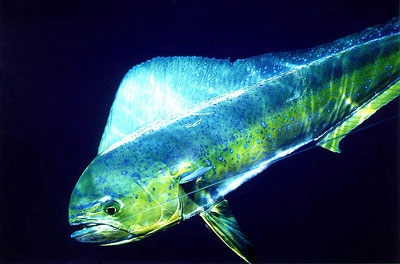
Predators
Not much is known regarding the predators of cobia, however they are presumably eaten by larger pelagic fishes. Dolphinfish (Coryphaena hippurus) have been reported to feed on small cobia.
Parasites
The majority of parasites are host-specific, suggesting this fish is not closely related to any other fishes. Parasites include a variety of trematodes, cestodes, nematodes, acanthocephalans, and copepods as well as barnacles. Thirty individuals of a single trematode species, Stephanostomum pseudoditrematis, were found in the intestine of a single cobia taken from the Indian Ocean. Infestations of the nematode Iheringascaris inquies are quite common in the stomachs of cobia.
Taxonomy

The cobia was originally described as Gasterosteus canadus by Linnaeus in 1766. It was later changed to Rachycentron candum (Linnaeus, 1766). Synonyms for the cobia include Apolectus niger Bloch 1793, Scomber niger Bloch 1793, Naucrates niger Bloch 1793, Elacate nigra Bloch 1793, Centronotus gardenii Lacepede 1801, Centronotus spinosusMitchill 1815, Rachycentron typus Kaup 1826, Elacate motta Cuvier and Valenciennes 1829, Elacate atlantica Cuvier and Valenciennes 1832, Elacate bivittata Cuvier and Valenciennes 1832, Elacate malabarica Cuvier and Valenciennes 1832,Elacate pondiceriana Cuvier and Valenciennes 1832, Meloderma nigerrima Swainson 1839, Naucrates niger Swainson 1839, Elacate falcipinnis Gosse 1851, Thynnus canadensis Gronow 1854, Elacate nigra Gunther 1860, Rachycentron canadus Jordan and Evermann 1896, and Rachycentron pondicerrianum Jordan 1905.Prepared by: Cathleen Bester